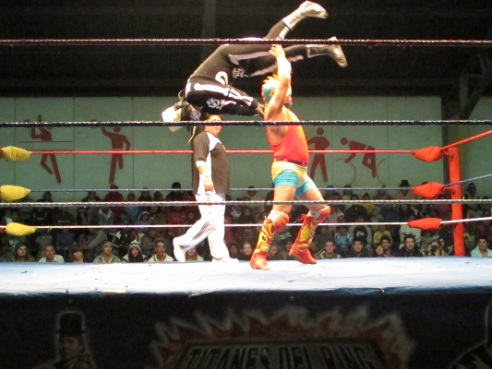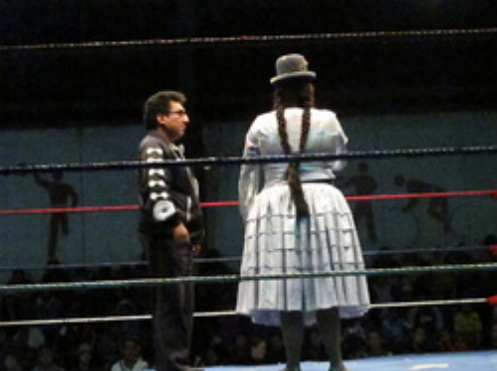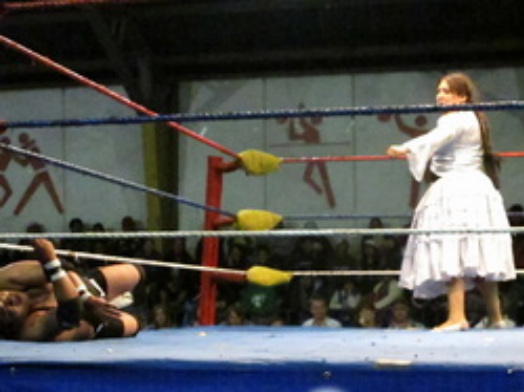|
Exhibition wrestling is a phenomenon that has grown in different ways in disparate regions. It began in US army barracks, quickly being picked up by promoters, and expanded across the US. A few decades later, Mexico City had adopted its own more acrobatic style. From there it spread across Latin America, and to other regions, with Argentina, Japan, and Brazil being among the most prominent examples. Bolivia, conversely, is not a prominent world example of lucha libre. Though lucha libre is a popular pastime in cities like La Paz, Cochabamba, and Santa Cruz, it has not been televised since 2001. Indeed even Bolivians see it as derrivative of other countries´ lucha libre. One fan told me “[lucha libre] is passion in Mexico, religion in Japan, and a joke in the United States, and here [in Bolivia] unfortunately, it suffers horrible stagnation and lacks creativity…It lacks vision of promoters, and the scripts, and stories, and characters are plagiarized from Mexico and the United States. Even the international lucha libre website, Superluchas, recently published a guest blog alleging that fans are tired of all the wrestling companies in Bolivia because they lack personality and plagiarize names, masks, and teams. And yet, the lucha libre of La Paz and El Alto has something that can´t be found elsewhere. It is, as one fan says, “obviously our contribution to the world of wrestling.” And that is the Cholitas Luchadoras. One might even suggest that this is not only Bolivia's contribution to the “world of wrestling” but also to the world at large, given the fact that Bolivia is a country that does not have a well-developed international image. In contrast to neighbor Perú’s annual 2 million tourists, Bolivia garners only 300,000. It lacks iconic places and events other Latin American countires boast, such as Perú’s Macchu Picchu, Guatamala's Chichen Itzu, and Brazilian Carnivale. It is landlocked and has the poorest economy in South America. The indigenous president, Evo Morales, is one of the most vocal speakers in the world on issues like climate change and indigenous rights. Yet, he is often portrayed as simply a Hugo Chavez minion. As one traveler told me "No one even knows where Bolivia is. The only thing it’s known for is maybe the cocaine." Indeed Morales´s recent challenge of coca´s inclusion in the United Nations 1961 Single Convention on Narcotic Drugs and the capital city La Paz´s reputation for clandestine cocaine bars, clearly belies the country’s embarassed assocation with drug abuse and proud (for some) association with coca cultivation. But the Cholitas Luchadoras are becoming another visible symbol of Bolivia. Cholitas, the diminutive of cholas, are already a central figure on postcards throughout the region. More an essentialization than a real “identity” (see Weismantel’s Cholas and Pishtacos), cholas are often envisioned as the traditional mothers of the nation, thought to be rural indigenous women, stuck in time (see Gill’s Precarious Dependencies). The luchadoras are only one of the most recent incarnations of the chola character, joining young women dancing in parades and festivals, dessert brand ambassadors in upscale La Paz supermarkets, and politically active drag performers. The luchadoras, however, have received far more attention than these other cholita incarnations. The Guardian has covered them in online video segments, and even newsmedia from Venezuela and Chile have given them attention. At a recent lucha libre event in La Paz a renowned Chilean journalist and his young producer trolled the audience asking opinions about lucha libre. When I reluctantly agreed to answer their questions, they repeatedly pressured me to talk about what I thought of the luchadoras. So the audience´s and even broader Paceño population´s suggestions that the luchadoras are the "pride" of La Paz may reflect their desire for international recognition. But this is not just because cholitas are "traditional" and unique to the Andes. The icon of the chola is deeply endowed with characteristics seen as part of Paceño identity….
0 Comments
Your comment will be posted after it is approved.
Leave a Reply. |
themes
All
archives
August 2022
|



 RSS Feed
RSS Feed
